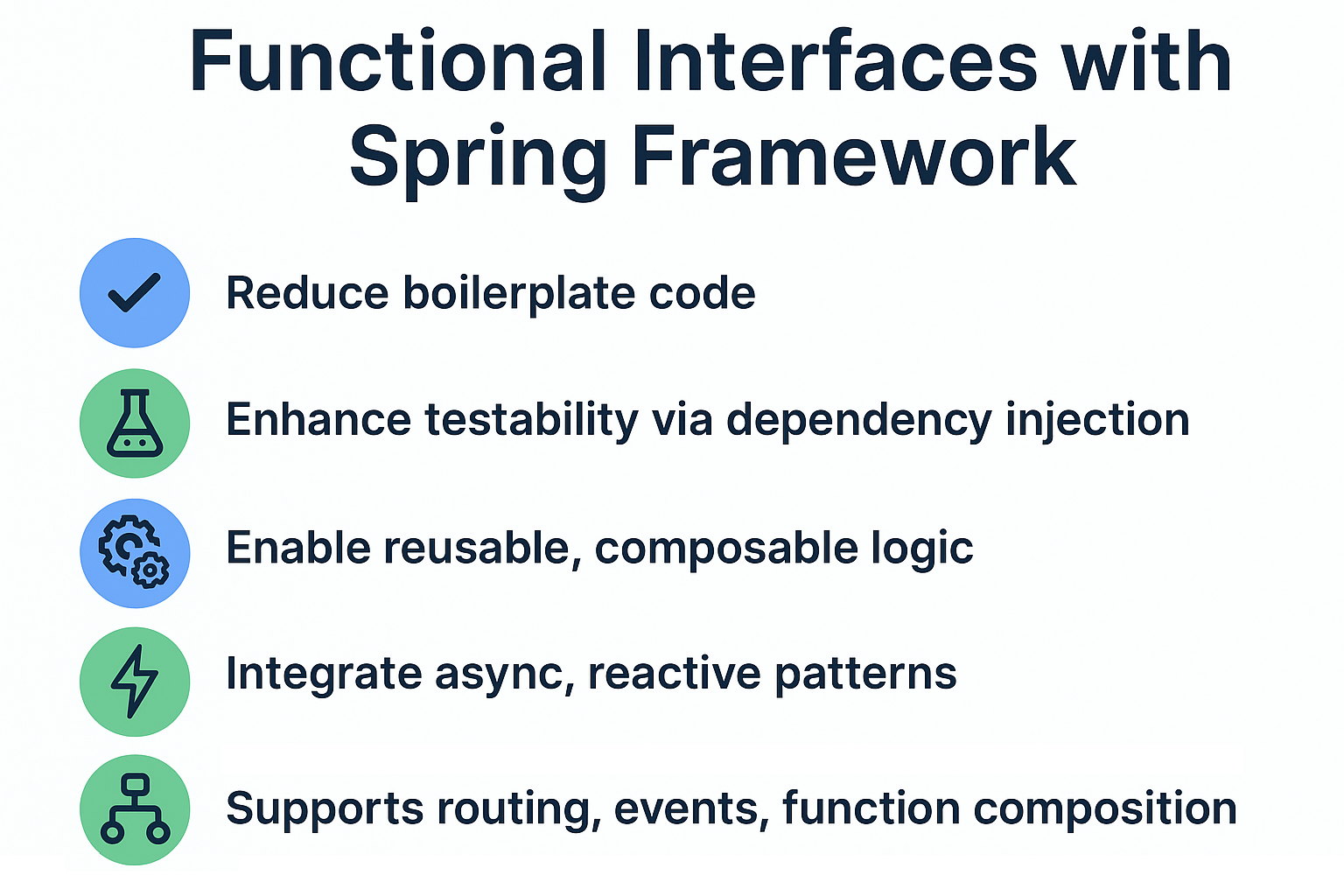Functional interfaces and lambda expressions are no longer just syntactic sugar—they're a key part of modern enterprise Java development, especially with the Spring Framework. From declarative event handling to clean service layers and functional routing, Spring embraces functional programming to improve modularity, testability, and maintainability.
In this tutorial, we’ll explore how to use functional interfaces with Spring, backed by real-world examples and best practices for clean code.
🔍 Recap: What Are Functional Interfaces?
A functional interface is any interface with a single abstract method (SAM). These are ideal for use with lambda expressions and method references, making code more concise.
@FunctionalInterface
interface Greeting {
void sayHello(String name);
}
Greeting greeting = name -> System.out.println("Hello " + name);
Common functional interfaces from java.util.function include:
Function<T, R>Predicate<T>Consumer<T>Supplier<T>BiFunction,UnaryOperator,Runnable,Callable
💡 Why Use Functional Interfaces with Spring?
- ✨ Reduce boilerplate code
- 🧪 Enhance testability via dependency injection
- 🔁 Enable reusable, composable business logic
- ⚡ Integrate async, reactive, and streaming patterns easily
📦 Integration Points in Spring Framework
1. Functional Routing in Spring WebFlux
@Bean
public RouterFunction<ServerResponse> route() {
return RouterFunctions
.route(GET("/hello"), request -> ServerResponse.ok().bodyValue("Hello, world"));
}
Functional Interface: HandlerFunction<ServerResponse>
2. Custom Strategies with Function<T, R>
Inject logic using Function to decouple services.
@Component
public class UserProcessor implements Function<User, UserDto> {
@Override
public UserDto apply(User user) {
return new UserDto(user.getId(), user.getName());
}
}
@Service
public class UserService {
private final Function<User, UserDto> transformer;
public UserService(Function<User, UserDto> transformer) {
this.transformer = transformer;
}
}
3. Spring Events with Consumer
@EventListener
public void handleUserCreated(UserCreatedEvent event) {
System.out.println("Handled event for: " + event.getUserId());
}
Can be replaced or wrapped with a Consumer<UserCreatedEvent> for modularity.
4. Scheduling and Threading with Runnable
@Scheduled(fixedRate = 1000)
public void task() {
executorService.submit(() -> System.out.println("Running task"));
}
5. Spring Cloud Function
Spring Cloud Function allows deploying Function, Consumer, and Supplier as cloud-native serverless components.
@Bean
public Function<String, String> uppercase() {
return value -> value.toUpperCase();
}
Supports AWS Lambda, Azure Functions, Kafka, HTTP, etc.
🧠 Functional Composition in Spring
Function<String, String> trim = String::trim;
Function<String, String> toLower = String::toLowerCase;
Function<String, String> pipeline = trim.andThen(toLower);
Apply composition to validator pipelines, interceptors, or data mappers.
⚙️ Real-World Use Case: Validation Pipeline
Predicate<String> notNull = Objects::nonNull;
Predicate<String> notEmpty = s -> !s.trim().isEmpty();
Predicate<String> isValid = notNull.and(notEmpty);
public boolean validate(String input) {
return isValid.test(input);
}
Inject these predicates via @Bean or config for modular logic.
📌 What's New in Java Versions?
Java 8
- Lambdas, Streams,
java.util.function, default methods
Java 9
Optional.ifPresentOrElse, Flow API
Java 11
- Local variable inference in lambdas (
var)
Java 17
- Pattern matching, sealed interfaces for functional style
Java 21
- Structured concurrency
- Scoped values
- Virtual threads (ideal for lambda-friendly async logic)
🚧 Pitfalls and Anti-Patterns
- ❌ Overusing lambdas without meaningful abstraction
- ❌ Catching checked exceptions inside complex chains
- ❌ Ignoring DI — avoid tightly coupling lambdas inside services
- ❌ Logging and mutating external state in
map(),filter(), etc.
🔄 Refactor to Functional with Spring
// Before
public String process(String input) {
if (input != null && input.length() > 3) {
return input.toUpperCase();
}
return "INVALID";
}
// After
Predicate<String> valid = s -> s != null && s.length() > 3;
Function<String, String> transform = String::toUpperCase;
public String process(String input) {
return valid.test(input) ? transform.apply(input) : "INVALID";
}
✅ Conclusion and Key Takeaways
- Functional interfaces integrate seamlessly with Spring's component model
- Use
Function,Consumer, andPredicateto inject business rules - Embrace functional routing, validation, and pipelines with minimal boilerplate
- Modular and testable logic is easier to achieve with functional patterns
❓ FAQ
1. Can I inject a functional interface as a Spring Bean?
Yes. Spring supports injecting Function, Predicate, and even your own interfaces.
2. How is Spring Cloud Function different from traditional beans?
It's a framework for deploying functions across multiple platforms (serverless, HTTP, messaging).
3. Do lambdas reduce performance in Spring apps?
Not significantly. JVM optimizes them well. Focus on readability and testability.
4. Can I log inside a lambda in Spring?
Yes, but prefer peek() or dedicated wrappers to avoid side effects.
5. Are functional interfaces serializable in Spring?
Only if explicitly declared Serializable. Avoid unless required.
6. Can functional interfaces throw checked exceptions?
No, unless wrapped. Use helper utilities to rethrow or convert to unchecked.
7. How do I unit test a lambda injected via Spring?
Use mock Function or Predicate and verify behavior using JUnit/Mockito.
8. Are lambdas GC’ed like regular objects?
Yes. They are instances created at runtime and subject to garbage collection.
9. Can I combine functional interfaces in configuration classes?
Absolutely. You can use composition to build powerful chains.
10. When should I avoid lambdas in Spring?
Avoid when clarity is sacrificed or when exception handling becomes convoluted.
